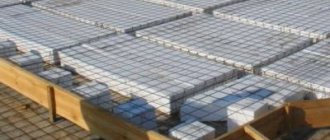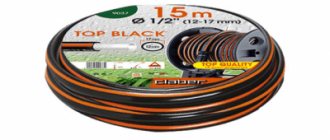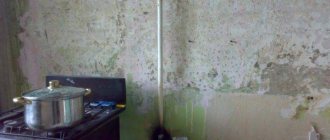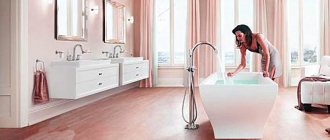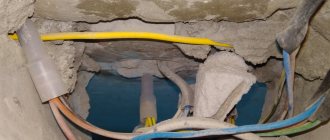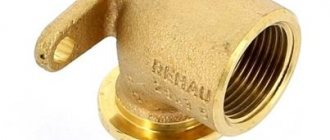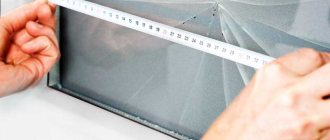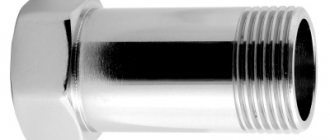At the final stage of plumbing work, faucets, shower stalls, wall-mounted toilets and bidets or other equipment are connected to the water supply system. This can be done using a rigid, bellows or flexible liner. The first option is much more reliable than the last two, but more labor-intensive; in addition, its execution requires not only the presence of a specialized tool, but also the skills to work with it. Therefore, bellows and flexible hoses (for example, hoses for kitchen faucets with a pull-out or pull-out shower head, shower, etc.) are more practical in everyday life.
What is flexible eyeliner?
First of all, it is necessary to emphasize that although this option for supplying water is considered budgetary, it is quite reliable, provided that the materials are correctly selected and the connection technology is followed.
In essence, a flexible water supply is a rubber hose (the same as a watering hose) placed in a tight-fitting braid made of metal threads. Its main purpose is protection against mechanical damage, both external and internal. The latter may occur due to water hammer. In accordance with the standards, such connecting hoses must be designed for a pressure of at least 10 atm.
Below is an example of connecting a herringbone kitchen sink faucet with flexible hoses (A) used to supply cold and hot water.
Connection example using flexible hoses
Please note that the sink siphon is connected to the sewer with a corresponding flexible connection (B).
Selecting a thread sealant
Rewinding is only needed for eccentrics.
The quality of installation of the mixer depends on how reliably the threaded connections are waterproofed. For this purpose use:
- Plumbing linen.
- Plumbing thread.
- FUM tape.
Linen is a time-tested material. Despite the emergence of many other methods of waterproofing, it is still popular among professional plumbers and amateurs. The quality of the seal is at a high level. Correct linen winding does not move when screwed in and is not cut by thread. The external bushing with flax winding can be adjusted in space, but by no more than ¼ turn.
To wind the thread, flax is twisted into a braid. Then they are wound tightly in one layer, so as to hide the thread. The tail of the thread must be clamped with the first turn. The direction of the winding should be opposite to the direction in which the part will be screwed. Then the flax will remain in place when connecting the threaded pair.
The only disadvantage of flax is that it is not slippery enough. It is imperative to use special plumbing lubricants (pastes) with it. They prevent the fibers from being cut when screwed in and allow the flax to crumple tightly along the thread, making the connection as reliable as possible. In addition, it protects flax from destruction under the influence of moisture.
Plumbing thread is a less common material for waterproofing threaded pairs, as it is quite expensive and has specific uses. The thread is wound not along the thread, but crosswise. The tail is also clamped with the first turn. The material is reliable and easy to use, ideal for small jobs. Allows you to twist the connection in the opposite direction up to half a turn.
FUM tape is a popular material among amateurs and professionals, as it is very easy to use and fix on the thread. The tape is wound in several layers - from 3 to 10, depending on the diameter of the threaded pair, the density of the connection without winding and the thickness of the tape itself. The winding should be done from the base of the thread to the edge. The tape is wound along the thread, pulling slightly. The end must be cut, not torn off. FUM tape is quite smooth, so it does not require the use of additional lubricant.
Important! After twisting, the element with a winding made of FUM tape cannot be rotated in the opposite direction. To immediately install the eccentric correctly, you need to tighten it without winding and remember the number of turns and location in space.
Kinds
These water hoses come in the following types:
- for connecting the washbasin mixer, shower cabin and other equipment to hot water. To identify them, red threads are added to the braid (“A” in Fig. 2);
- for connection with cold water supply pipes. Their braid contains blue threads (“B”);
- universal, allow connection to any type of water supply. The braid of such pipes is marked red and blue (“C”).
Rice.
2. Hoses for cold and hot water, as well as universal ones. In addition, the hoses differ in the braid material, which is reflected in certain characteristics, namely:
- Aluminum reinforcement. Currently practically not used. The only advantage is the low price, which is not justified due to the short service life (3 years). In addition, such protection cannot withstand pressures of more than 5 atm. But the main drawback of such products is their instability to corrosion. In a damp room, the braid quickly deteriorates, after which the rubber hose quickly becomes unusable. Therefore, such pipes can be used when connecting kitchen equipment, for example, a mixer with a pull-out shower head (with a flexible hose), but they are not suitable for a bathroom or shower.
Aluminum braided eyeliner - Stainless steel braid (the most common type). This design option significantly extends the service life (a high-quality product can be used for at least 10 years). These pipes can withstand a pressure of 10 atm and they have no restrictions on the type of premises, that is, installation is allowed even in a steam room.
Stainless steel braided eyeliner - Nylon braiding significantly improves performance. Such products can be used for 15 years, and they are designed for pressures of up to 20 atm and a temperature of the technical environment of 110°C. True, the cost of these pipes is higher than that of the two previous types. In domestic conditions, there is no need for such high performance, so it is not advisable to use eyeliner with nylon braid.
Nylon braided liner
There are pipes where the hoses are made not of rubber, but of rubber; such products are more reliable, but also much more expensive.
As additional protection, the braid can be coated with a silicone layer, according to manufacturers, this allows the service life to be extended to 20 years.
Bellows liner.
Despite the fact that it is also physically flexible, it is customary to distinguish this type of eyeliner as a separate type, due to significant design differences. The peculiarity of the bellows liner is that the shell is a metal corrugation, strong, but at the same time flexible; in addition, there is no rubber hose inside.
Bellows liner
It is also worth noting that the fitting together with the terminal clamp are connected to the corrugated hose by welding, this significantly increases the reliability of the design. The service life of products of this type is at least 25 years, and they can be used to work with process environments heated to 250°C. As a rule, corrugation is made of stainless steel, but there are VIP category plumbing fixtures where brass and copper are used for this purpose.
This is a new type of eyeliner, and at the moment no non-original products have been noticed on the market. As for the price, it is significantly higher than conventional connecting hoses.
The best brands
Among most manufacturers there are the most popular companies. These include German companies Grohe and ProFactor, which produce high-quality products. The products are durable, reliable, but expensive. There is a brand from Italy called Remer, which is a competitor to its German counterparts. You can find fakes from this company; they do not include all the components for the mixer.
Among domestic brands, ST Giant eyeliner from Santrade is distinguished. Reviews about this product are mixed. The company produces products at different prices. Products of low cost are of poor quality, hence the different opinions of consumers.
The Spanish brand Industrials Mateu has high product performance and always controls its quality. Products are manufactured according to international quality standards. The Turkish company Rispa, founded in China, has an affordable price and fairly good quality. The product can operate uninterruptedly for many years. Therefore, if you have a limited budget, you can buy products from this company.
Installation of connecting hoses
Having dealt with the types, let us consider for general reference the typical design of a flexible liner.
Rice. 7. Design of flexible pipes for mixers
The product consists of the following main elements:
- Sealing gaskets to ensure the tightness of the connection and prevent leakage “A”.
- Brass or steel nipple "B".
- Rubber or caoutchouc hose “C”.
- Aluminum, stainless steel or nylon “D” protective braid.
- Press the sleeve (clamping the nipple) “E”.
- Connecting fitting (steel or brass) “F”.
- Union nut "G".
The liner is manufactured with three types of connections: nut-nut, fitting-nut and fitting-fitting. Standard sizes for the nut are 1/2“, for the fitting - M10. Sometimes you may come across a non-standard connection, for example an M8 fitting or a 3/8“ nut. In this case, you will need an appropriate adapter for a kitchen faucet or other equipment.
The length of flexible hoses can be from 500 to 2000 mm; we recommend choosing the appropriate size so as not to install extension connections.
Note that the fitting can be short or long. The latter is more convenient to connect the mixer.
Eyeliner with short and long fittings
Material of manufacture
Regardless of the type of connection chosen, the main selection criterion is quality. Of course, this affects the price, but it’s not worth saving: a good hose for a kitchen faucet means both a low probability of leaks and durability.
Things to consider:
- Appearance of the product. It should not be deformed or too thin.
- The manufacturer is also important: unknown companies are too risky a choice. They often make a cheap but not reliable product.
- It’s good if the seller is ready to provide quality certificates.
Tip : to avoid lifting heavy pots of water, you can purchase Novara-Plusс. It is equipped with an exhaust hose.
Features of materials used in the manufacture of eyeliner:
- Steel - durable galvanized pipes are not afraid of rust. May expand slightly at high temperatures.
- Copper is ductile, does not rust, disinfects water, and remains operational at +250 °C.
- Brass - withstands up to +300 degrees, resistant to chlorine, high pressure (up to 400 atmospheres).
How to choose a faucet hose?
Experts recommend that when choosing flexible hoses for installing plumbing fixtures in the kitchen or bathroom, pay attention to the following details:
- Having a label with the specified technical characteristics will help prevent mistakes. Make sure the diameter and type of fastener matches your equipment.
- Be sure to pay attention to the weight of the product; if it has an aluminum braid, the hose will be much lighter than one that uses steel (in most cases, such products have a fitting of dubious quality). As practice shows, they quickly fail, literally within six months, or even earlier.
- You should discard the liner if it is equipped with a plastic fitting; such a mount is not designed for the load required for domestic purposes.
- If the hose is insufficiently flexible, you should also not purchase it, since this sign indicates poor quality. As a rule, this causes several microcracks to appear in the braid, which can cause deformation.
- Pay attention to the sleeve press; stainless steel should be used as the material for them. It is important that their tubes are held tightly - this is an indicator of high-quality pressing.
- Check the design of the union nuts; if they are very thin or light, it means that this is a low-quality product and there is a high probability of problems when using it.
- Low-quality rubber has a sharp, characteristic odor; if you find one, discard this model, since such material will begin to leak quite quickly.
- When choosing hoses for hot water, do not make a mistake with the color marking; they should have a red or red-blue thread; those with a blue mark are not suitable.
- Choose an eyeliner of the appropriate length; it is not advisable for it to sag or be stretched.
- Many branded devices (for example, Damixa or Hansgrohe) include 50 cm hoses. To connect a faucet in the kitchen , the length is quite enough, but to connect other equipment they may be short, for example, the standard placement above the bathtub is 150 cm. In this case, you can remove them and screw the liner of the required length or use it as an extension cord. The last option is not entirely successful. This is due to the fact that an extra connection will appear in the extended hose, which means reliability will decrease.
- Which product to choose, imported or domestically produced, does not really matter; we note that our products are sometimes better and more reliable than foreign ones.
Dimensions
Before purchasing a product, you should determine the required length. Most branded models come with a 50 cm hose included. This is enough to connect a faucet in the kitchen.
It is important to take preliminary measurements, since the layout of the room and the placement of water supply points may differ. The diameter of the union nut is also important. It can be ⅜ - 1”. The fitting has a standard value - M10.
Recommendation : A large family will benefit from a double sink like the N200. It will fit twice as many dishes.
The method of connecting the hose to the faucet in the kitchen may differ:
- Petal Latch + Fitting - Simply push the tube into the bottom of the faucet until you hear a click.
- Thread - the part is simply screwed in.
- The push-in connector is a cylinder-shaped sleeve, which on one side is divided into 4 petals. By rotating the nuts, they bend towards the center, which ensures fixation.
Educational program: What does a kitchen faucet consist of: 5 different models


